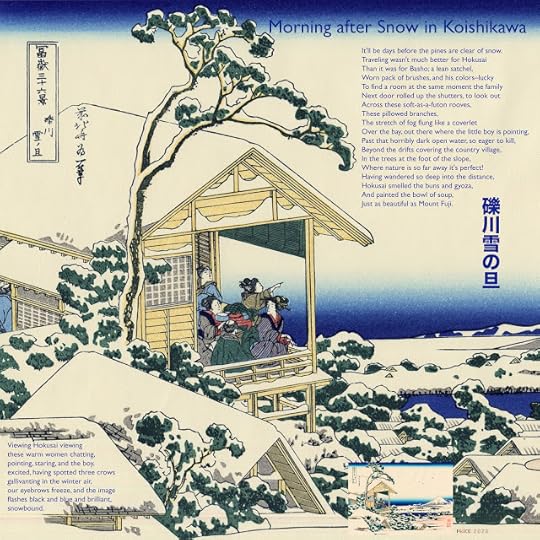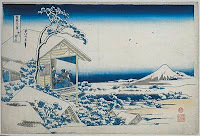Jonathan Price's Blog, page 5
April 11, 2023
02Viewing Hokusai--Morning After Snow in Koishikawa
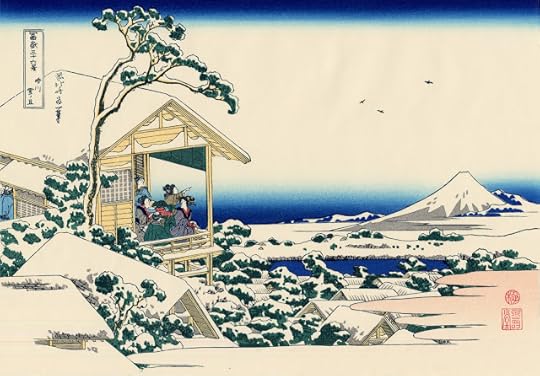 Hokusai, 礫川雪の旦,
Hokusai, 礫川雪の旦, Morning After Snow in Koishikawa
It'll be days before the pines are clear of snow.
Traveling wasn't much better for Hokusai
Than it was for Bashō; a lean satchel,
Worn pack of brushes, and his colors--lucky
To find a room at the same moment the family
Next door rolled up the shutters, to look out
Across these soft-as-a-futon rooves, these pillowed branches,
The stretch of fog flung like a coverlet
Over the bay, out there where the little boy is pointing,
Past that horribly dark open water, so eager to kill,
Beyond the drifts covering the country village,
In the trees at the foot of the slope,
Where nature is so far away it's perfect!
Having wandered so deep into the distance,
Hokusai smelled the buns and gyoza,
And painted the bowl of soup,
Just as beautiful as Mount Fuji.
--Jonathan Reeve Price
Another Interpretation of Morning After Snow in KoishikawaHere's another take on the same image, starting from Hokusai's original, mixing text and images into a 24"x24" aluminum panel, catalogued in my book, Viewing Hokusai Viewing Mount Fuji.
Other images in this series:In this project, we take off from each picture in Hokusai's 36 Views of Mount Fuji, plus the extras he added when customers asked for more. We look at each original, then offer a visual and textual exploration of questions such as:
What was Hokusai getting at? How was he working? How did this practice align with his spiritual growth?Please skim down this set of thumbnails to spot a picture you might want to explore, then click through. Or get the complete set in the book, Viewing Hokusai Viewing Mount Fuji.
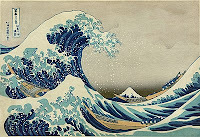
1 View through Waves off the Coast of Kanagawa
2 Morning after Snow in Koishikawa
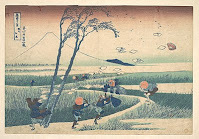
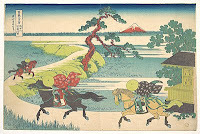
4 Sekiya Village on the Sumida River
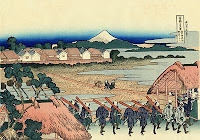
5 View from Senju in Musashi Province
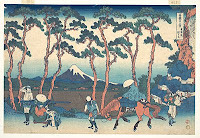
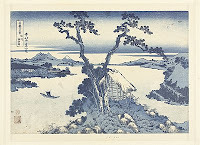 7 Lake Suwa in Shinano
7 Lake Suwa in Shinano
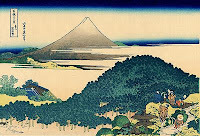 8 Cushion Pine at Aoyama
8 Cushion Pine at Aoyama
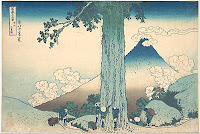 9 At Mishima Pass in Kai
9 At Mishima Pass in Kai
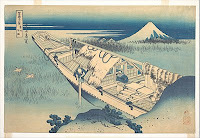 10 Ushibori in Hitachi
10 Ushibori in Hitachi
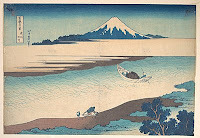 11 Tama River in Musashi
11 Tama River in Musashi
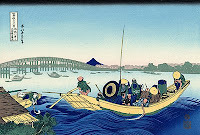 12 Sunset across the Ryōgoku Bridge from Sumida
12 Sunset across the Ryōgoku Bridge from Sumida
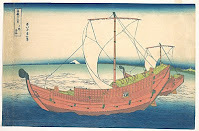 13 Sea Lane off Kazusa
13 Sea Lane off Kazusa
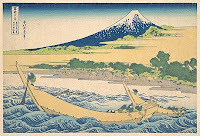 14 Off Tago Beach in Ejiri on the Tokaido
14 Off Tago Beach in Ejiri on the Tokaido
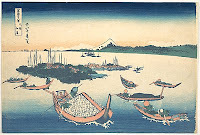 15 Tsukada-jima in Musashi Province
15 Tsukada-jima in Musashi Province
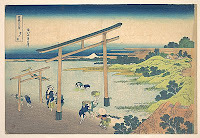 16 Bay of Noboto
16 Bay of Noboto
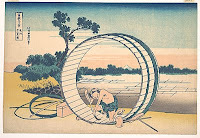 17 Fujimigahara in Owari
17 Fujimigahara in Owari
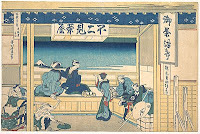 18 Yoshida on the Tōkaidō Highway
18 Yoshida on the Tōkaidō Highway
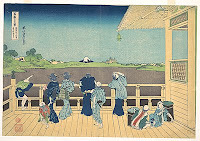 19 Sazai Hall, Temple of the 500 Arhats
19 Sazai Hall, Temple of the 500 Arhats
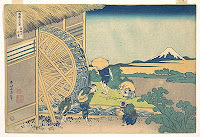 20 Watermill at Onden
20 Watermill at Onden
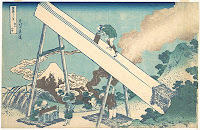 21 In the Mountains of Tōtōmi
21 In the Mountains of Tōtōmi
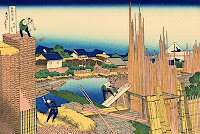 22 Tatekawa in Honjo
22 Tatekawa in Honjo
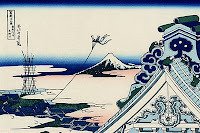 23 Hongan-ji Temple at Asakusa
23 Hongan-ji Temple at Asakusa
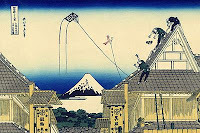 24 Mitsui Shop at Suruga-chō in Edo
24 Mitsui Shop at Suruga-chō in Edo
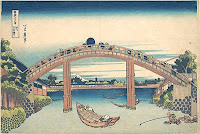 25 Under the Mannen Bridge in Fukagawa
25 Under the Mannen Bridge in Fukagawa
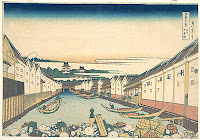 26 Nihonbashi
26 Nihonbashi
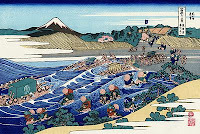 27 Crossing the Ōi River at Kanaya
27 Crossing the Ōi River at Kanaya
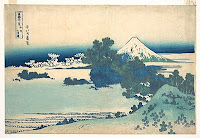 28 Shichiri Beach in Sagami
28 Shichiri Beach in Sagami
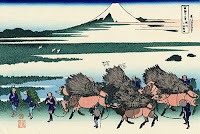 29 New Fields at Ōno Shinden
29 New Fields at Ōno Shinden
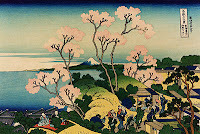 30 Hills at Gotenyama above Shinagawa
30 Hills at Gotenyama above Shinagawa
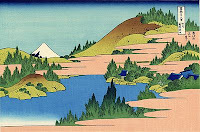 31 The Lake at Hakone in Sagami
31 The Lake at Hakone in Sagami
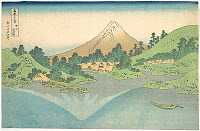 32 Misaka in Kai
32 Misaka in Kai
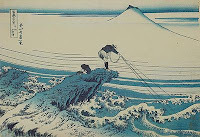 33 Kajikazawa in Kai Province
33 Kajikazawa in Kai Province
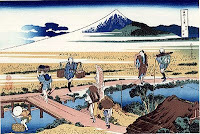 34 Nakahara in Sagami
34 Nakahara in Sagami
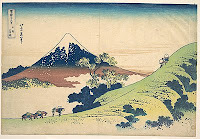 35 The Inume Pass in Kai Province
35 The Inume Pass in Kai Province
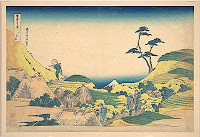 36 Shimo Meguro
36 Shimo Meguro
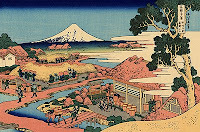
37 Tea Fields at Katakura in Suruga
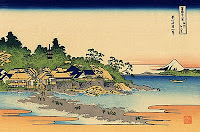 38 Sōshū Enoshima in Sagami
38 Sōshū Enoshima in Sagami
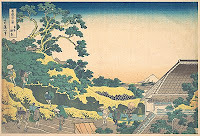 39 Surugadai in Edo
39 Surugadai in Edo
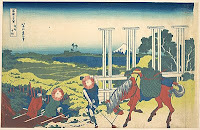 40 Senju in Musashi Province
40 Senju in Musashi Province
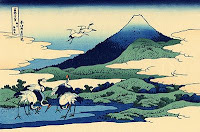 41 The Fields of Umezawa in Sagami
41 The Fields of Umezawa in Sagami
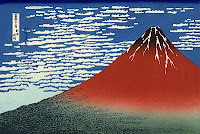 42 A Fine, Breezy Day
42 A Fine, Breezy Day
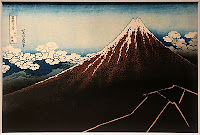 43 Storm Below the Summit
43 Storm Below the Summit
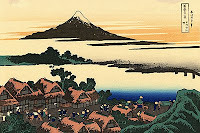 44 Dawn at Isawa in Kai Province
44 Dawn at Isawa in Kai Province
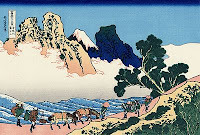 45 The Other Side of Mt. Fuji, from Minobu River
45 The Other Side of Mt. Fuji, from Minobu River
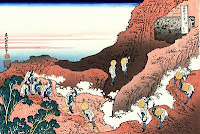 46 Climbing Mt. Fuji
46 Climbing Mt. Fuji
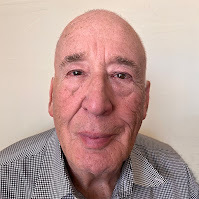
47:Viewing Hokusai--Afterword About Hokusai, Me, and MonetAbout the BookViewing Hokusai Viewing Mount FujiISBN-10: 0-9719954-7-8 ISBN-13: 978-0-9719954-7-576 pages, full colorThis book is a meditation on Hokusai, taking apart the prints in the series, 36 Views of Mount Fuji, zooming in digitally, assembling a 21st century interpretation of his practice, as he celebrates the natural landscape of a nation coming up with a new idea of itself.
Each image starts with one of Hokusai’s views, disassembles it, constructs a new picture out of the pieces, as a visual critique, and adds floating text chunks—brief observations, snippets of poetry, stray thoughts.
Thumbnails of the originals let you compare the before-and-after, gauging Hokusai’s wood-block print against the pixelated, sliced, and diced collage, and the scattered writings that reflect on his drive for immortality, his exploitation of newly available pigments, his fondness for the interplay of text and image, and his love for the ordinary workers and travelers out in the country.
An Afterword discusses the path that the artist and poet, Jonathan Reeve Price, took to this homage to Hokusai. He sees parallels between Hokusai’s art practice and the functions available in software such as Photoshop, tactics that he has adapted to our century—zooming, revising, layering, making depth hard to read, indulging in bright blocks of color. Hokusai created more than a thousand images combining poetry and imagery, and Price points to those artworks as justification for his own mixing of language, line, and color in his responses.
In 19th century Japan, the number 36 might have reminded literate customers of the number of the immortals—the classical poets of Japan and China. But when Hokusai’s series of 36 prints sold well, he added another 10 pictures. So this book offers a total of 46 digital images, followed by a critical essay, and an FAQ about the author’s background. Holding this book in your hand may not make you live forever, but, who knows, it might bring you some of Hokusai’s spirit.
Viewing Hokusai Viewing Mount Fuji
About Me
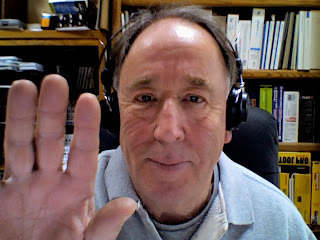 I'm Jonathan Reeve Price, an information architect, writer, and artist.
I'm Jonathan Reeve Price, an information architect, writer, and artist. Linked In: http://www.linkedin.com/in/JonathanReevePrice
Amazon Author Page: https://www.amazon.com/author/jonathanprice
Twitter: http://twitter.com/JonathanRPrice
Museum Zero: museumzero.art
April 10, 2023
03Viewing Hokusai--Ejiri in Suruga
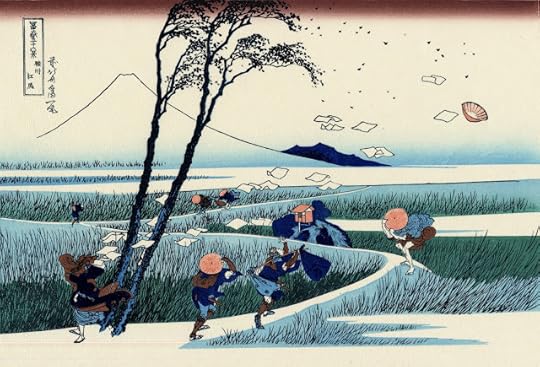 Hokusai, 駿州江尻, Ejiri in Suruga
Hokusai, 駿州江尻, Ejiri in SurugaThere goes your data! This great wind,
Like a hard disk crash, explodes
The message, blasting pages into the air,
Tossing the bamboo hat, too, toward the swamp.
Thank God for the twin elms, teetering, too,
But bracing our heroine so she does not spin like the
Leaves being torn away, to ride,
Confused birds, tossed crazily by the gale.
The trees reach up so high they break the frame,
Convincing us that the mountain still lies behind,
The two slopes and a crater all sketched in one line,
A suggestion of a form, a ghost.
These folks up front, tangled and twisted,
Bent double against the roar, blown
Nearly off the trail, grab hat and cloth,
Haul tight their bags, staggering home.
But this woman's lost her vision,
Hair thrashing, hat gone, her pile
Of papers rippling off, rat a tat,
Before she can clap a hand on top,
Gone, the love letters from the samurai,
Lost, the bills and accounts, streaked and
Ruined, the print of the kabuki.
The brushstrokes blur in mid air,
Rain rushing down, pummeling paper
Into the long grass, each blade
Whipping like a furious pen.
Slash, slash, slash, these white stretches
Cut back and forth, making the mounded pathway
Rise out of the reeds, zigzagging
East and west, and down to the horizon.
White water slices into the marsh,
Lake's bright line divides us from
The far shore, the simple line
Silhouetting, no, separating sky's light
From the snow on the floating middle ground,
The translucent Mount Fuji.
--Jonathan Reeve Price
Another Interpretation of Ejiri in SurugaHere's another take on the same image, starting from Hokusai's original, mixing text and images in 24"x24" aluminum panels, catalogued in my book, Viewing Hokusai Viewing Mount Fuji.
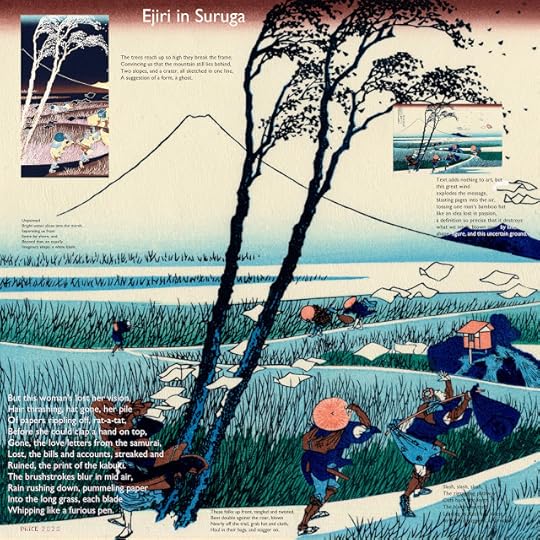
For Jason Farago's take on this picture, see "A Picture of Change for a World in Constant Motion" (August 7, 2020).
Other images in this series:https://www.nytimes.com/interactive/2020/08/07/arts/design/hokusai-fuji.html
In this project, we take off from each picture in Hokusai's 36 Views of Mount Fuji, plus the extras he added when customers asked for more. We look at each original, then offer a visual and textual exploration of questions such as:
What was Hokusai getting at? How was he working? How did this practice align with his spiritual growth?Please skim down this set of thumbnails to spot a picture you might want to explore, then click through. Or get the complete set in the book, Viewing Hokusai Viewing Mount Fuji.

1 View through Waves off the Coast of Kanagawa
2 Morning after Snow in Koishikawa


4 Sekiya Village on the Sumida River

5 View from Senju in Musashi Province

 7 Lake Suwa in Shinano
7 Lake Suwa in Shinano
 8 Cushion Pine at Aoyama
8 Cushion Pine at Aoyama
 9 At Mishima Pass in Kai
9 At Mishima Pass in Kai
 10 Ushibori in Hitachi
10 Ushibori in Hitachi
 11 Tama River in Musashi
11 Tama River in Musashi
 12 Sunset across the Ryōgoku Bridge from Sumida
12 Sunset across the Ryōgoku Bridge from Sumida
 13 Sea Lane off Kazusa
13 Sea Lane off Kazusa
 14 Off Tago Beach in Ejiri on the Tokaido
14 Off Tago Beach in Ejiri on the Tokaido
 15 Tsukada-jima in Musashi Province
15 Tsukada-jima in Musashi Province
 16 Bay of Noboto
16 Bay of Noboto
 17 Fujimigahara in Owari
17 Fujimigahara in Owari
 18 Yoshida on the Tōkaidō Highway
18 Yoshida on the Tōkaidō Highway
 19 Sazai Hall, Temple of the 500 Arhats
19 Sazai Hall, Temple of the 500 Arhats
 20 Watermill at Onden
20 Watermill at Onden
 21 In the Mountains of Tōtōmi
21 In the Mountains of Tōtōmi
 22 Tatekawa in Honjo
22 Tatekawa in Honjo
 23 Hongan-ji Temple at Asakusa
23 Hongan-ji Temple at Asakusa
 24 Mitsui Shop at Suruga-chō in Edo
24 Mitsui Shop at Suruga-chō in Edo
 25 Under the Mannen Bridge in Fukagawa
25 Under the Mannen Bridge in Fukagawa
 26 Nihonbashi
26 Nihonbashi
 27 Crossing the Ōi River at Kanaya
27 Crossing the Ōi River at Kanaya
 28 Shichiri Beach in Sagami
28 Shichiri Beach in Sagami
 29 New Fields at Ōno Shinden
29 New Fields at Ōno Shinden
 30 Hills at Gotenyama above Shinagawa
30 Hills at Gotenyama above Shinagawa
 31 The Lake at Hakone in Sagami
31 The Lake at Hakone in Sagami
 32 Misaka in Kai
32 Misaka in Kai
 33 Kajikazawa in Kai Province
33 Kajikazawa in Kai Province
 34 Nakahara in Sagami
34 Nakahara in Sagami
 35 The Inume Pass in Kai Province
35 The Inume Pass in Kai Province
 36 Shimo Meguro
36 Shimo Meguro

37 Tea Fields at Katakura in Suruga
 38 Sōshū Enoshima in Sagami
38 Sōshū Enoshima in Sagami
 39 Surugadai in Edo
39 Surugadai in Edo
 40 Senju in Musashi Province
40 Senju in Musashi Province
 41 The Fields of Umezawa in Sagami
41 The Fields of Umezawa in Sagami
 42 A Fine, Breezy Day
42 A Fine, Breezy Day
 43 Storm Below the Summit
43 Storm Below the Summit
 44 Dawn at Isawa in Kai Province
44 Dawn at Isawa in Kai Province
 45 The Other Side of Mt. Fuji, from Minobu River
45 The Other Side of Mt. Fuji, from Minobu River
 46 Climbing Mt. Fuji
46 Climbing Mt. Fuji

47:Viewing Hokusai--Afterword About Hokusai, Me, and MonetAbout the BookViewing Hokusai Viewing Mount FujiISBN-10: 0-9719954-7-8 ISBN-13: 978-0-9719954-7-576 pages, full colorThis book is a meditation on Hokusai, taking apart his prints in the series, 36 Views of Mount Fuji, zooming in digitally, assembling a 21st century interpretation of his practice, as he celebrates the natural landscape of a nation coming up with a new idea of itself.
Each image starts with one of Hokusai’s views, disassembles it, constructs a new picture out of the pieces, as a visual critique, and adds floating text chunks—brief observations, snippets of poetry, stray thoughts.
Thumbnails of the originals let you compare the before-and-after, gauging Hokusai’s wood-block print against the pixelated, sliced, and diced collage, and the scattered writings that reflect on his drive for immortality, his exploitation of newly available pigments, his fondness for the interplay of text and image, and his love for the ordinary workers and travelers out in the country.
An Afterword discusses the path that the artist and poet, Jonathan Reeve Price, took to this homage to Hokusai. He sees parallels between Hokusai’s art practice and the functions available in software such as Photoshop, tactics that he has adapted to our century—zooming, revising, layering, making depth hard to read, indulging in bright blocks of color. Hokusai created more than a thousand images combining poetry and imagery, and Price points to those artworks as justification for his own mixing of language, line, and color in his responses.
In 19th century Japan, the number 36 might have reminded literate customers of the number of the immortals—the classical poets of Japan and China. But when Hokusai’s series of 36 prints sold well, he added another 10 pictures. So this book offers a total of 46 digital images, followed by a critical essay, and an FAQ about the author’s background. Holding this book in your hand may not make you live forever, but, who knows, it might bring you some of Hokusai’s spirit.
Viewing Hokusai Viewing Mount Fuji
About Me
 I'm Jonathan Reeve Price, an information architect, writer, and artist.
I'm Jonathan Reeve Price, an information architect, writer, and artist. Linked In: http://www.linkedin.com/in/JonathanReevePrice
Amazon Author Page: https://www.amazon.com/author/jonathanprice
Twitter: http://twitter.com/JonathanRPrice
Museum Zero: museumzero.art
April 8, 2023
04Viewing Hokusai--Sekiya Village on the Sumida River
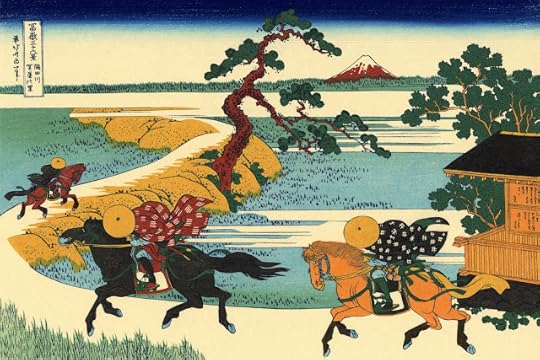
Hokusai, 隅田川関屋の里,
Sekiya Village on the Sumida River
Like bicycle messengers in New York, these samurai
Gouge flanks, lifting up off the back, jockeying around
This curve from the mainland, across rice paddies,
Toward what? Intense mutterings, meetings,
Explosions. So quickly forgotten, that reason
They rushed past Sekiya, down to the Sumida.
The inn sign invites them to pause,
Take off their bamboo hats, round as wheels,
Uncinch, and take hot tea.
But it's too early in the morning, too late
For mist to have completely cleared;
The water is as white as fog; the moist cold air
Slices across the panel,
Conveniently providing depth,
Like that oddly placed tree, tilted
As crazily as the upraised road.
Roan, black, and palomino, head up or down,
The horses plunge ahead; the riders' kimonos
Balloon in flight, the men
Faceless as they bend into the wind.
Behind them, the volcano broods,
Red in the first sun, spreading its spirit over
Peasants, inn, rice fields, and these samurai,
Over the immense river,
The long forest and the unobserved
Hokusai, imagining himself right there, right then,
Facing off with his icon, Mount Fuji.
--Jonathan Reeve Price
Another Interpretation of Sekiya Village on the Sumida RiverHere's another take on the same image, starting from Hokusai's original, mixing text and images in 24"x24" aluminum panels, catalogued in my book, Viewing Hokusai Viewing Mount Fuji.
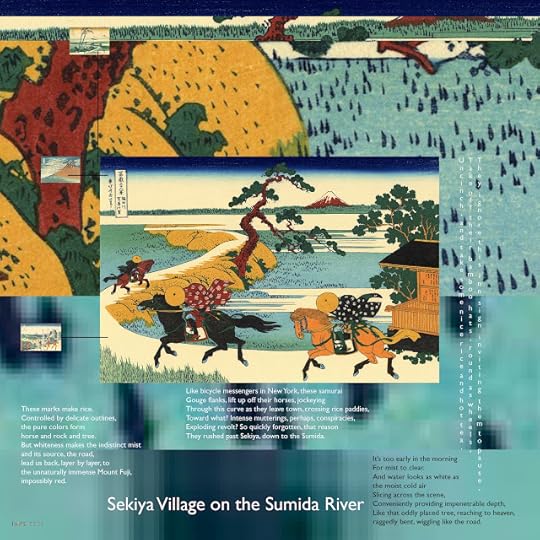
Other images in this series:
In this project, we take off from each picture in Hokusai's 36 Views of Mount Fuji, plus the extras he added when customers asked for more. We look at each original, then offer a visual and textual exploration of questions such as:
What was Hokusai getting at? How was he working? How did this practice align with his spiritual growth?Please skim down this set of thumbnails to spot a picture you might want to explore, then click through. Or get the complete set in the book, Viewing Hokusai Viewing Mount Fuji.

1 View through Waves off the Coast of Kanagawa
2 Morning after Snow in Koishikawa


4 Sekiya Village on the Sumida River

5 View from Senju in Musashi Province

 7 Lake Suwa in Shinano
7 Lake Suwa in Shinano
 8 Cushion Pine at Aoyama
8 Cushion Pine at Aoyama
 9 At Mishima Pass in Kai
9 At Mishima Pass in Kai
 10 Ushibori in Hitachi
10 Ushibori in Hitachi
 11 Tama River in Musashi
11 Tama River in Musashi
 12 Sunset across the Ryōgoku Bridge from Sumida
12 Sunset across the Ryōgoku Bridge from Sumida
 13 Sea Lane off Kazusa
13 Sea Lane off Kazusa
 14 Off Tago Beach in Ejiri on the Tokaido
14 Off Tago Beach in Ejiri on the Tokaido
 15 Tsukada-jima in Musashi Province
15 Tsukada-jima in Musashi Province
 16 Bay of Noboto
16 Bay of Noboto
 17 Fujimigahara in Owari
17 Fujimigahara in Owari
 18 Yoshida on the Tōkaidō Highway
18 Yoshida on the Tōkaidō Highway
 19 Sazai Hall, Temple of the 500 Arhats
19 Sazai Hall, Temple of the 500 Arhats
 20 Watermill at Onden
20 Watermill at Onden
 21 In the Mountains of Tōtōmi
21 In the Mountains of Tōtōmi
 22 Tatekawa in Honjo
22 Tatekawa in Honjo
 23 Hongan-ji Temple at Asakusa
23 Hongan-ji Temple at Asakusa
 24 Mitsui Shop at Suruga-chō in Edo
24 Mitsui Shop at Suruga-chō in Edo
 25 Under the Mannen Bridge in Fukagawa
25 Under the Mannen Bridge in Fukagawa
 26 Nihonbashi
26 Nihonbashi
 27 Crossing the Ōi River at Kanaya
27 Crossing the Ōi River at Kanaya
 28 Shichiri Beach in Sagami
28 Shichiri Beach in Sagami
 29 New Fields at Ōno Shinden
29 New Fields at Ōno Shinden
 30 Hills at Gotenyama above Shinagawa
30 Hills at Gotenyama above Shinagawa
 31 The Lake at Hakone in Sagami
31 The Lake at Hakone in Sagami
 32 Misaka in Kai
32 Misaka in Kai
 33 Kajikazawa in Kai Province
33 Kajikazawa in Kai Province
 34 Nakahara in Sagami
34 Nakahara in Sagami
 35 The Inume Pass in Kai Province
35 The Inume Pass in Kai Province
 36 Shimo Meguro
36 Shimo Meguro

37 Tea Fields at Katakura in Suruga
 38 Sōshū Enoshima in Sagami
38 Sōshū Enoshima in Sagami
 39 Surugadai in Edo
39 Surugadai in Edo
 40 Senju in Musashi Province
40 Senju in Musashi Province
 41 The Fields of Umezawa in Sagami
41 The Fields of Umezawa in Sagami
 42 A Fine, Breezy Day
42 A Fine, Breezy Day
 43 Storm Below the Summit
43 Storm Below the Summit
 44 Dawn at Isawa in Kai Province
44 Dawn at Isawa in Kai Province
 45 The Other Side of Mt. Fuji, from Minobu River
45 The Other Side of Mt. Fuji, from Minobu River
 46 Climbing Mt. Fuji
46 Climbing Mt. Fuji

47:Viewing Hokusai--Afterword About Hokusai, Me, and MonetAbout the BookViewing Hokusai Viewing Mount FujiISBN-10: 0-9719954-7-8 ISBN-13: 978-0-9719954-7-576 pages, full colorThis book is a meditation on Hokusai, taking apart the prints in the series, 36 Views of Mount Fuji, zooming in digitally, assembling a 21st century interpretation of his practice, as he celebrates the natural landscape of a nation coming up with a new idea of itself.
Each image starts with one of Hokusai’s views, disassembles it, constructs a new picture out of the pieces, as a visual critique, and adds floating text chunks—brief observations, snippets of poetry, stray thoughts.
Thumbnails of the originals let you compare the before-and-after, gauging Hokusai’s wood-block print against the pixelated, sliced, and diced collage, and the scattered writings that reflect on his drive for immortality, his exploitation of newly available pigments, his fondness for the interplay of text and image, and his love for the ordinary workers and travelers out in the country.
An Afterword discusses the path that the artist and poet, Jonathan Reeve Price, took to this homage to Hokusai. He sees parallels between Hokusai’s art practice and the functions available in software such as Photoshop, tactics that he has adapted to our century—zooming, revising, layering, making depth hard to read, indulging in bright blocks of color. Hokusai created more than a thousand images combining poetry and imagery, and Price points to those artworks as justification for his own mixing of language, line, and color in his responses.
In 19th century Japan, the number 36 might have reminded literate customers of the number of the immortals—the classical poets of Japan and China. But when Hokusai’s series of 36 prints sold well, he added another 10 pictures. So this book offers a total of 46 digital images, followed by a critical essay, and an FAQ about the author’s background. Holding this book in your hand may not make you live forever, but, who knows, it might bring you some of Hokusai’s spirit.
Viewing Hokusai Viewing Mount Fuji
About Me
 I'm Jonathan Reeve Price, an information architect, writer, and artist.
I'm Jonathan Reeve Price, an information architect, writer, and artist. Linked In: http://www.linkedin.com/in/JonathanReevePrice
Amazon Author Page: https://www.amazon.com/author/jonathanprice
Twitter: http://twitter.com/JonathanRPrice
Museum Zero: museumzero.art
April 7, 2023
05Viewing Hokusai--View from Senju in Musashi Province.
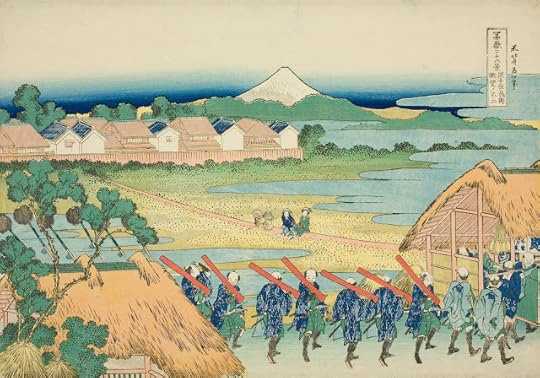 Hokusai, 武州千住, View from Senju in Musashi Province
Hokusai, 武州千住, View from Senju in Musashi Province The archers I saw in the subway headed for the competition carried
Red tubes like these. A little short for the long curve of a bow,
Too light for a broad sword, these gun tubes look menacing.
Are those short blades at their waists?
Why so many in uniform?
Trouble trundling through the village,
And the two women out on the trail
Sit down to watch, perhaps hoping to be able to say,
We saw it all, from the beach path.
Left foot, right foot, shoulder
Pitched and turned, the soldiers
Form a line, yes, but each makes
His own saunter, sneer, or stare.
Against the sameness of the houses on the far side,
And the flatness of the in-reach of the bay,
These men seem out of order, headed every which way,
Tilting their red tubes so many directions that
They recall deliberate randomness, numbers chosen
Because they form no order we can recognize.
Threatening as this group of guards might be,
They slouch like a bowling team waiting for tickets.
Now their long march ends in the shelter on the right,
As they're checked in. Perhaps no fight broke out,
No one got raped, they just plodded on in the morning.
Their shaved heads look so ordinary,
As they saunter forward, a few staring out
At the women, the village, the breeze,
Or the biggest bald head of all, Mount Fuji.
--Jonathan Reeve Price
Another Interpretation of View from Senju in Musashi ProvinceHere's another take on the same image, starting from Hokusai's original, mixing text and images in 24"x24" aluminum panels, catalogued in my book, Viewing Hokusai Viewing Mount Fuji.
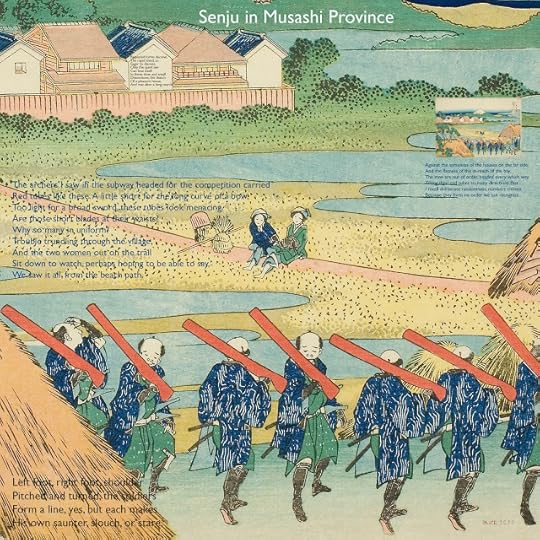 Other images in this series:
Other images in this series:In this project, we take off from each picture in Hokusai's 36 Views of Mount Fuji, plus the extras he added when customers asked for more. We look at each original, then offer a visual and textual exploration of questions such as:
What was Hokusai getting at? How was he working? How did this practice align with his spiritual growth?Please skim down this set of thumbnails to spot a picture you might want to explore, then click through. Or get the complete set in the book, Viewing Hokusai Viewing Mount Fuji.

1 View through Waves off the Coast of Kanagawa
2 Morning after Snow in Koishikawa


4 Sekiya Village on the Sumida River

5 View from Senju in Musashi Province

 7 Lake Suwa in Shinano
7 Lake Suwa in Shinano
 8 Cushion Pine at Aoyama
8 Cushion Pine at Aoyama
 9 At Mishima Pass in Kai
9 At Mishima Pass in Kai
 10 Ushibori in Hitachi
10 Ushibori in Hitachi
 11 Tama River in Musashi
11 Tama River in Musashi
 12 Sunset across the Ryōgoku Bridge from Sumida
12 Sunset across the Ryōgoku Bridge from Sumida
 13 Sea Lane off Kazusa
13 Sea Lane off Kazusa
 14 Off Tago Beach in Ejiri on the Tokaido
14 Off Tago Beach in Ejiri on the Tokaido
 15 Tsukada-jima in Musashi Province
15 Tsukada-jima in Musashi Province
 16 Bay of Noboto
16 Bay of Noboto
 17 Fujimigahara in Owari
17 Fujimigahara in Owari
 18 Yoshida on the Tōkaidō Highway
18 Yoshida on the Tōkaidō Highway
 19 Sazai Hall, Temple of the 500 Arhats
19 Sazai Hall, Temple of the 500 Arhats
 20 Watermill at Onden
20 Watermill at Onden
 21 In the Mountains of Tōtōmi
21 In the Mountains of Tōtōmi
 22 Tatekawa in Honjo
22 Tatekawa in Honjo
 23 Hongan-ji Temple at Asakusa
23 Hongan-ji Temple at Asakusa
 24 Mitsui Shop at Suruga-chō in Edo
24 Mitsui Shop at Suruga-chō in Edo
 25 Under the Mannen Bridge in Fukagawa
25 Under the Mannen Bridge in Fukagawa
 26 Nihonbashi
26 Nihonbashi
 27 Crossing the Ōi River at Kanaya
27 Crossing the Ōi River at Kanaya
 28 Shichiri Beach in Sagami
28 Shichiri Beach in Sagami
 29 New Fields at Ōno Shinden
29 New Fields at Ōno Shinden
 30 Hills at Gotenyama above Shinagawa
30 Hills at Gotenyama above Shinagawa
 31 The Lake at Hakone in Sagami
31 The Lake at Hakone in Sagami
 32 Misaka in Kai
32 Misaka in Kai
 33 Kajikazawa in Kai Province
33 Kajikazawa in Kai Province
 34 Nakahara in Sagami
34 Nakahara in Sagami
 35 The Inume Pass in Kai Province
35 The Inume Pass in Kai Province
 36 Shimo Meguro
36 Shimo Meguro

37 Tea Fields at Katakura in Suruga
 38 Sōshū Enoshima in Sagami
38 Sōshū Enoshima in Sagami
 39 Surugadai in Edo
39 Surugadai in Edo
 40 Senju in Musashi Province
40 Senju in Musashi Province
 41 The Fields of Umezawa in Sagami
41 The Fields of Umezawa in Sagami
 42 A Fine, Breezy Day
42 A Fine, Breezy Day
 43 Storm Below the Summit
43 Storm Below the Summit
 44 Dawn at Isawa in Kai Province
44 Dawn at Isawa in Kai Province
 45 The Other Side of Mt. Fuji, from Minobu River
45 The Other Side of Mt. Fuji, from Minobu River
 46 Climbing Mt. Fuji
46 Climbing Mt. Fuji

47:Viewing Hokusai--Afterword About Hokusai, Me, and MonetAbout the BookViewing Hokusai Viewing Mount FujiISBN-10: 0-9719954-7-8 ISBN-13: 978-0-9719954-7-576 pages, full colorThis book is a meditation on Hokusai, taking apart the prints in the series, 36 Views of Mount Fuji, zooming in digitally, assembling a 21st century interpretation of his practice, as he celebrates the natural landscape of a nation coming up with a new idea of itself.
Each image starts with one of Hokusai’s views, disassembles it, constructs a new picture out of the pieces, as a visual critique, and adds floating text chunks—brief observations, snippets of poetry, stray thoughts.
Thumbnails of the originals let you compare the before-and-after, gauging Hokusai’s wood-block print against the pixelated, sliced, and diced collage, and the scattered writings that reflect on his drive for immortality, his exploitation of newly available pigments, his fondness for the interplay of text and image, and his love for the ordinary workers and travelers out in the country.
An Afterword discusses the path that the artist and poet, Jonathan Reeve Price, took to this homage to Hokusai. He sees parallels between Hokusai’s art practice and the functions available in software such as Photoshop, tactics that he has adapted to our century—zooming, revising, layering, making depth hard to read, indulging in bright blocks of color. Hokusai created more than a thousand images combining poetry and imagery, and Price points to those artworks as justification for his own mixing of language, line, and color in his responses.
In 19th century Japan, the number 36 might have reminded literate customers of the number of the immortals—the classical poets of Japan and China. But when Hokusai’s series of 36 prints sold well, he added another 10 pictures. So this book offers a total of 46 digital images, followed by a critical essay, and an FAQ about the author’s background. Holding this book in your hand may not make you live forever, but, who knows, it might bring you some of Hokusai’s spirit.
Viewing Hokusai Viewing Mount Fuji
About Me
 I'm Jonathan Reeve Price, an information architect, writer, and artist.
I'm Jonathan Reeve Price, an information architect, writer, and artist. Linked In: http://www.linkedin.com/in/JonathanReevePrice
Amazon Author Page: https://www.amazon.com/author/jonathanprice
Twitter: http://twitter.com/JonathanRPrice
Museum Zero: museumzero.art
April 6, 2023
06Viewing Hokusai--Hodogaya on the Tōkaidō
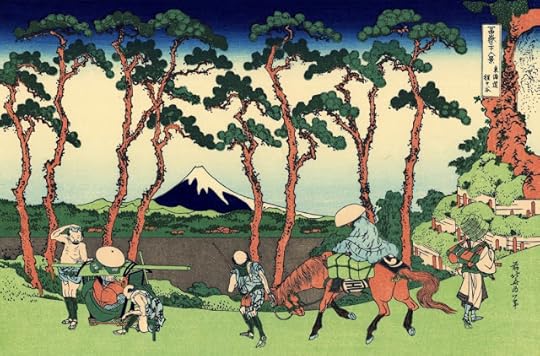 Hokusai, 東海道保土ケ谷,
Hokusai, 東海道保土ケ谷, Hodogaya on the Tōkaidō
Like a decorated curtain, the trees
Arise between us and the dirty lake,
Isolating the performers here in front of us,
Each trunk a module in the rhythm
Of the open road to the far north--
How personal each traveler is, uniquely
Bending to look in his or her own way:
Introspective, worshipful, itchy, awed, or
Indifferent; even the horse has his own idea.
Inside the palanquin, the baby sleeps.
Terraces hold back the tumbling dirt,
Resisting the temptation to become pure cliff--
Hokusai relished these neat divisions,
Daring to make the trail so pure that
No rock sticks in the shoe, smoothing
The lake like wood veneer,
Painting sky in three broad bands--
These restraining walls separate and emphasize,
Making multiple stage sets, and yet,
By stretching from east to west,
These lines form the staff, the trees
The baseline, and these quivering pedestrians
Raise the melody.
Absorbing silence, the far hill
Sits dreaming of
Being a butterfly, no, a human,
Anything that can flutter up to become,
In that clean cold air, the crescendo,
The finale, the grace note of life--Mount Fuji.
--Jonathan Reeve Price
Another Interpretation of Hodogaya on the TōkaidōHere's another take on the same image, starting from Hokusai's original, mixing text and images in 24"x24" aluminum panels, catalogued in my book, Viewing Hokusai Viewing Mount Fuji.
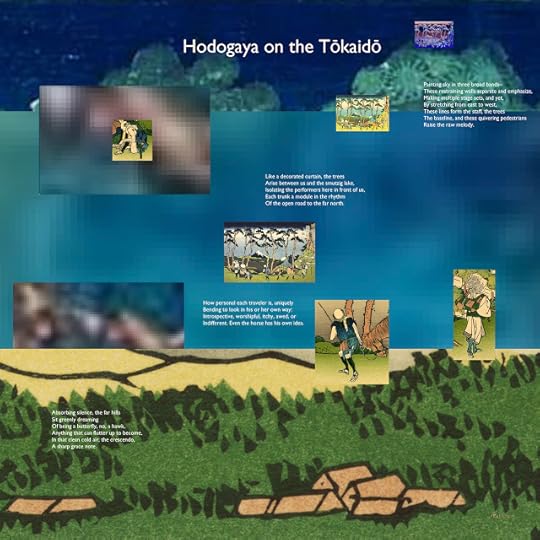 Other images in this series:
Other images in this series:In this project, we take off from each picture in Hokusai's 36 Views of Mount Fuji, plus the extras he added when customers asked for more. We look at each original, then offer a visual and textual exploration of questions such as:
What was Hokusai getting at? How was he working? How did this practice align with his spiritual growth?Please skim down this set of thumbnails to spot a picture you might want to explore, then click through. Or get the complete set in the book, Viewing Hokusai Viewing Mount Fuji.

1 View through Waves off the Coast of Kanagawa
2 Morning after Snow in Koishikawa


4 Sekiya Village on the Sumida River

5 View from Senju in Musashi Province

 7 Lake Suwa in Shinano
7 Lake Suwa in Shinano
 8 Cushion Pine at Aoyama
8 Cushion Pine at Aoyama
 9 At Mishima Pass in Kai
9 At Mishima Pass in Kai
 10 Ushibori in Hitachi
10 Ushibori in Hitachi
 11 Tama River in Musashi
11 Tama River in Musashi
 12 Sunset across the Ryōgoku Bridge from Sumida
12 Sunset across the Ryōgoku Bridge from Sumida
 13 Sea Lane off Kazusa
13 Sea Lane off Kazusa
 14 Off Tago Beach in Ejiri on the Tokaido
14 Off Tago Beach in Ejiri on the Tokaido
 15 Tsukada-jima in Musashi Province
15 Tsukada-jima in Musashi Province
 16 Bay of Noboto
16 Bay of Noboto
 17 Fujimigahara in Owari
17 Fujimigahara in Owari
 18 Yoshida on the Tōkaidō Highway
18 Yoshida on the Tōkaidō Highway
 19 Sazai Hall, Temple of the 500 Arhats
19 Sazai Hall, Temple of the 500 Arhats
 20 Watermill at Onden
20 Watermill at Onden
 21 In the Mountains of Tōtōmi
21 In the Mountains of Tōtōmi
 22 Tatekawa in Honjo
22 Tatekawa in Honjo
 23 Hongan-ji Temple at Asakusa
23 Hongan-ji Temple at Asakusa
 24 Mitsui Shop at Suruga-chō in Edo
24 Mitsui Shop at Suruga-chō in Edo
 25 Under the Mannen Bridge in Fukagawa
25 Under the Mannen Bridge in Fukagawa
 26 Nihonbashi
26 Nihonbashi
 27 Crossing the Ōi River at Kanaya
27 Crossing the Ōi River at Kanaya
 28 Shichiri Beach in Sagami
28 Shichiri Beach in Sagami
 29 New Fields at Ōno Shinden
29 New Fields at Ōno Shinden
 30 Hills at Gotenyama above Shinagawa
30 Hills at Gotenyama above Shinagawa
 31 The Lake at Hakone in Sagami
31 The Lake at Hakone in Sagami
 32 Misaka in Kai
32 Misaka in Kai
 33 Kajikazawa in Kai Province
33 Kajikazawa in Kai Province
 34 Nakahara in Sagami
34 Nakahara in Sagami
 35 The Inume Pass in Kai Province
35 The Inume Pass in Kai Province
 36 Shimo Meguro
36 Shimo Meguro

37 Tea Fields at Katakura in Suruga
 38 Sōshū Enoshima in Sagami
38 Sōshū Enoshima in Sagami
 39 Surugadai in Edo
39 Surugadai in Edo
 40 Senju in Musashi Province
40 Senju in Musashi Province
 41 The Fields of Umezawa in Sagami
41 The Fields of Umezawa in Sagami
 42 A Fine, Breezy Day
42 A Fine, Breezy Day
 43 Storm Below the Summit
43 Storm Below the Summit
 44 Dawn at Isawa in Kai Province
44 Dawn at Isawa in Kai Province
 45 The Other Side of Mt. Fuji, from Minobu River
45 The Other Side of Mt. Fuji, from Minobu River
 46 Climbing Mt. Fuji
46 Climbing Mt. Fuji

47:Viewing Hokusai--Afterword About Hokusai, Me, and MonetAbout the BookViewing Hokusai Viewing Mount FujiISBN-10: 0-9719954-7-8 ISBN-13: 978-0-9719954-7-576 pages, full colorThis book is a meditation on Hokusai, taking apart the prints in the series, 36 Views of Mount Fuji, zooming in digitally, assembling a 21st century interpretation of his practice, as he celebrates the natural landscape of a nation coming up with a new idea of itself.
Each image starts with one of Hokusai’s views, disassembles it, constructs a new picture out of the pieces, as a visual critique, and adds floating text chunks—brief observations, snippets of poetry, stray thoughts.
Thumbnails of the originals let you compare the before-and-after, gauging Hokusai’s wood-block print against the pixelated, sliced, and diced collage, and the scattered writings that reflect on his drive for immortality, his exploitation of newly available pigments, his fondness for the interplay of text and image, and his love for the ordinary workers and travelers out in the country.
An Afterword discusses the path that the artist and poet, Jonathan Reeve Price, took to this homage to Hokusai. He sees parallels between Hokusai’s art practice and the functions available in software such as Photoshop, tactics that he has adapted to our century—zooming, revising, layering, making depth hard to read, indulging in bright blocks of color. Hokusai created more than a thousand images combining poetry and imagery, and Price points to those artworks as justification for his own mixing of language, line, and color in his responses.
In 19th century Japan, the number 36 might have reminded literate customers of the number of the immortals—the classical poets of Japan and China. But when Hokusai’s series of 36 prints sold well, he added another 10 pictures. So this book offers a total of 46 digital images, followed by a critical essay, and an FAQ about the author’s background. Holding this book in your hand may not make you live forever, but, who knows, it might bring you some of Hokusai’s spirit.
Viewing Hokusai Viewing Mount Fuji
About Me
 I'm Jonathan Reeve Price, an information architect, writer, and artist.
I'm Jonathan Reeve Price, an information architect, writer, and artist. Linked In: http://www.linkedin.com/in/JonathanReevePrice
Amazon Author Page: https://www.amazon.com/author/jonathanprice
Twitter: http://twitter.com/JonathanRPrice
Museum Zero: museumzero.art
April 5, 2023
07Viewing Hokusai--Lake Suwa in Shinano
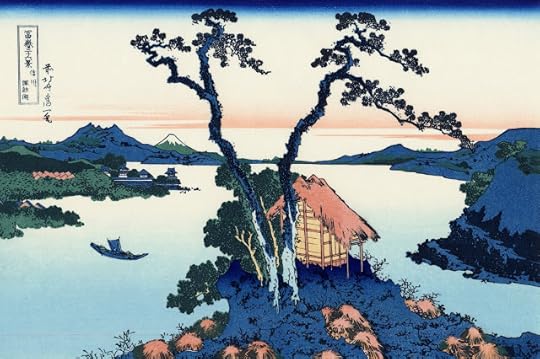 Hokusai, 信州諏訪湖,
Hokusai, 信州諏訪湖, Lake Suwa in Shinano
How Chinese this shack on a crag
So far above the lake we see the ship as a toy.
Hokusai deleted intervening trees,
Bushes, hills--we fall from this rock
Hundreds of feet, past rocks we can't see,
To the water--there's not even a beach.
The sudden sharp drop makes the hill
Seem flat, some point poking out.
Forward and back the hut goes, Escher-like,
As our eye and mind contend--
And right there Hokusai grows two trees,
Splitting the scene in half, tearing
The sky with wretched twisted trunks,
Branches blasted by updrafts.
As we approach the house, the rocks
Seem like bamboo huts; perhaps
They intend to toss the house over.
Both sides of the lake exist as splotches,
Undefined, nearly as opaque as this white sky.
Bravura in annihilating people,
Hokusai explodes the near, stills the far,
And omits the in-between; nervous,
Fogless, he turns this chaste scene
Into one big erratic path leading
To the horizontal blue of hills, and, oh yes,
As casually as a magician revealing a coin,
That one recognizable bump, Mount Fuji.
--Jonathan Reeve Price
Another Interpretation of Lake Suwa in ShinanoHere's another take on the same image, starting from Hokusai's original, mixing text and images in 24"x24" aluminum panels, catalogued in my book, Viewing Hokusai Viewing Mount Fuji.
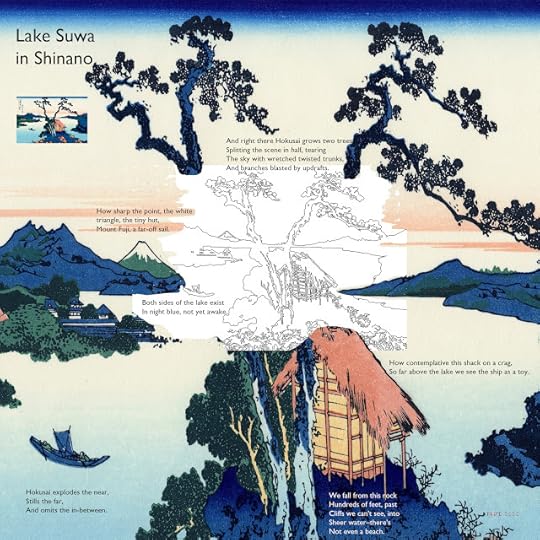 Other images in this series:
Other images in this series:In this project, we take off from each picture in Hokusai's 36 Views of Mount Fuji, plus the extras he added when customers asked for more. We look at each original, then offer a visual and textual exploration of questions such as:
What was Hokusai getting at? How was he working? How did this practice align with his spiritual growth?Please skim down this set of thumbnails to spot a picture you might want to explore, then click through. Or get the complete set in the book, Viewing Hokusai Viewing Mount Fuji.

1 View through Waves off the Coast of Kanagawa
2 Morning after Snow in Koishikawa


4 Sekiya Village on the Sumida River

5 View from Senju in Musashi Province

 7 Lake Suwa in Shinano
7 Lake Suwa in Shinano
 8 Cushion Pine at Aoyama
8 Cushion Pine at Aoyama
 9 At Mishima Pass in Kai
9 At Mishima Pass in Kai
 10 Ushibori in Hitachi
10 Ushibori in Hitachi
 11 Tama River in Musashi
11 Tama River in Musashi
 12 Sunset across the Ryōgoku Bridge from Sumida
12 Sunset across the Ryōgoku Bridge from Sumida
 13 Sea Lane off Kazusa
13 Sea Lane off Kazusa
 14 Off Tago Beach in Ejiri on the Tokaido
14 Off Tago Beach in Ejiri on the Tokaido
 15 Tsukada-jima in Musashi Province
15 Tsukada-jima in Musashi Province
 16 Bay of Noboto
16 Bay of Noboto
 17 Fujimigahara in Owari
17 Fujimigahara in Owari
 18 Yoshida on the Tōkaidō Highway
18 Yoshida on the Tōkaidō Highway
 19 Sazai Hall, Temple of the 500 Arhats
19 Sazai Hall, Temple of the 500 Arhats
 20 Watermill at Onden
20 Watermill at Onden
 21 In the Mountains of Tōtōmi
21 In the Mountains of Tōtōmi
 22 Tatekawa in Honjo
22 Tatekawa in Honjo
 23 Hongan-ji Temple at Asakusa
23 Hongan-ji Temple at Asakusa
 24 Mitsui Shop at Suruga-chō in Edo
24 Mitsui Shop at Suruga-chō in Edo
 25 Under the Mannen Bridge in Fukagawa
25 Under the Mannen Bridge in Fukagawa
 26 Nihonbashi
26 Nihonbashi
 27 Crossing the Ōi River at Kanaya
27 Crossing the Ōi River at Kanaya
 28 Shichiri Beach in Sagami
28 Shichiri Beach in Sagami
 29 New Fields at Ōno Shinden
29 New Fields at Ōno Shinden
 30 Hills at Gotenyama above Shinagawa
30 Hills at Gotenyama above Shinagawa
 31 The Lake at Hakone in Sagami
31 The Lake at Hakone in Sagami
 32 Misaka in Kai
32 Misaka in Kai
 33 Kajikazawa in Kai Province
33 Kajikazawa in Kai Province
 34 Nakahara in Sagami
34 Nakahara in Sagami
 35 The Inume Pass in Kai Province
35 The Inume Pass in Kai Province
 36 Shimo Meguro
36 Shimo Meguro

37 Tea Fields at Katakura in Suruga
 38 Sōshū Enoshima in Sagami
38 Sōshū Enoshima in Sagami
 39 Surugadai in Edo
39 Surugadai in Edo
 40 Senju in Musashi Province
40 Senju in Musashi Province
 41 The Fields of Umezawa in Sagami
41 The Fields of Umezawa in Sagami
 42 A Fine, Breezy Day
42 A Fine, Breezy Day
 43 Storm Below the Summit
43 Storm Below the Summit
 44 Dawn at Isawa in Kai Province
44 Dawn at Isawa in Kai Province
 45 The Other Side of Mt. Fuji, from Minobu River
45 The Other Side of Mt. Fuji, from Minobu River
 46 Climbing Mt. Fuji
46 Climbing Mt. Fuji

47:Viewing Hokusai--Afterword About Hokusai, Me, and MonetAbout the BookViewing Hokusai Viewing Mount FujiISBN-10: 0-9719954-7-8 ISBN-13: 978-0-9719954-7-576 pages, full colorThis book is a meditation on Hokusai, taking apart the prints in the series, 36 Views of Mount Fuji, zooming in digitally, assembling a 21st century interpretation of his practice, as he celebrates the natural landscape of a nation coming up with a new idea of itself.
Each image starts with one of Hokusai’s views, disassembles it, constructs a new picture out of the pieces, as a visual critique, and adds floating text chunks—brief observations, snippets of poetry, stray thoughts.
Thumbnails of the originals let you compare the before-and-after, gauging Hokusai’s wood-block print against the pixelated, sliced, and diced collage, and the scattered writings that reflect on his drive for immortality, his exploitation of newly available pigments, his fondness for the interplay of text and image, and his love for the ordinary workers and travelers out in the country.
An Afterword discusses the path that the artist and poet, Jonathan Reeve Price, took to this homage to Hokusai. He sees parallels between Hokusai’s art practice and the functions available in software such as Photoshop, tactics that he has adapted to our century—zooming, revising, layering, making depth hard to read, indulging in bright blocks of color. Hokusai created more than a thousand images combining poetry and imagery, and Price points to those artworks as justification for his own mixing of language, line, and color in his responses.
In 19th century Japan, the number 36 might have reminded literate customers of the number of the immortals—the classical poets of Japan and China. But when Hokusai’s series of 36 prints sold well, he added another 10 pictures. So this book offers a total of 46 digital images, followed by a critical essay, and an FAQ about the author’s background. Holding this book in your hand may not make you live forever, but, who knows, it might bring you some of Hokusai’s spirit.
Viewing Hokusai Viewing Mount Fuji
About Me
 I'm Jonathan Reeve Price, an information architect, writer, and artist.
I'm Jonathan Reeve Price, an information architect, writer, and artist. Linked In: http://www.linkedin.com/in/JonathanReevePrice
Amazon Author Page: https://www.amazon.com/author/jonathanprice
Twitter: http://twitter.com/JonathanRPrice
Museum Zero: museumzero.art
April 4, 2023
08Viewing Hokusai--The Cushion Pine at Aoyama
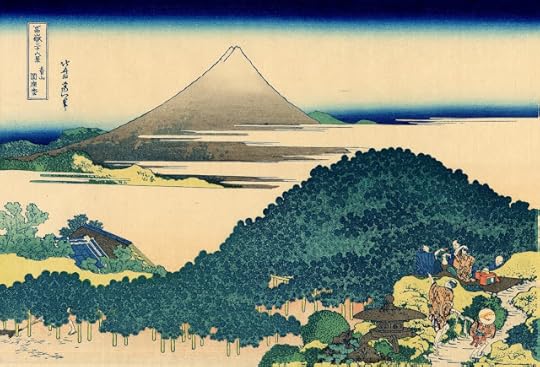 Hokusai, 青山円座松,
Hokusai, 青山円座松,The Cushion Pine at Aoyama
It’s not a hill,
This soft blue
Cushion, extending
Like grass down
The slope, it's a forest
With one root.
No haiku here--we get the whole hill,
And down here in a corner, out on the ledge,
Humans intrude, no, celebrate the view--
One traveler points out Fuji to his friend
While the others sit, next to wood chests,
Sharing a single red lacquer bowl.
--Jonathan Reeve Price
Another Interpretation of The Cushion Pine at AoyamaHere's another take on the same image, starting from Hokusai's original, mixing text and images in 24"x24" aluminum panels, catalogued in my book, Viewing Hokusai Viewing Mount Fuji.
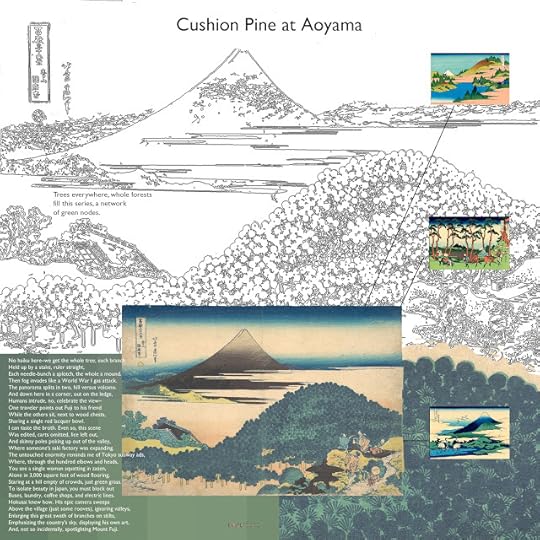
Other images in this series:
In this project, we take off from each picture in Hokusai's 36 Views of Mount Fuji, plus the extras he added when customers asked for more. We look at each original, then offer a visual and textual exploration of questions such as:
What was Hokusai getting at? How was he working? How did this practice align with his spiritual growth?Please skim down this set of thumbnails to spot a picture you might want to explore, then click through. Or get the complete set in the book, Viewing Hokusai Viewing Mount Fuji.

1 View through Waves off the Coast of Kanagawa
2 Morning after Snow in Koishikawa


4 Sekiya Village on the Sumida River

5 View from Senju in Musashi Province

 7 Lake Suwa in Shinano
7 Lake Suwa in Shinano
 8 Cushion Pine at Aoyama
8 Cushion Pine at Aoyama
 9 At Mishima Pass in Kai
9 At Mishima Pass in Kai
 10 Ushibori in Hitachi
10 Ushibori in Hitachi
 11 Tama River in Musashi
11 Tama River in Musashi
 12 Sunset across the Ryōgoku Bridge from Sumida
12 Sunset across the Ryōgoku Bridge from Sumida
 13 Sea Lane off Kazusa
13 Sea Lane off Kazusa
 14 Off Tago Beach in Ejiri on the Tokaido
14 Off Tago Beach in Ejiri on the Tokaido
 15 Tsukada-jima in Musashi Province
15 Tsukada-jima in Musashi Province
 16 Bay of Noboto
16 Bay of Noboto
 17 Fujimigahara in Owari
17 Fujimigahara in Owari
 18 Yoshida on the Tōkaidō Highway
18 Yoshida on the Tōkaidō Highway
 19 Sazai Hall, Temple of the 500 Arhats
19 Sazai Hall, Temple of the 500 Arhats
 20 Watermill at Onden
20 Watermill at Onden
 21 In the Mountains of Tōtōmi
21 In the Mountains of Tōtōmi
 22 Tatekawa in Honjo
22 Tatekawa in Honjo
 23 Hongan-ji Temple at Asakusa
23 Hongan-ji Temple at Asakusa
 24 Mitsui Shop at Suruga-chō in Edo
24 Mitsui Shop at Suruga-chō in Edo
 25 Under the Mannen Bridge in Fukagawa
25 Under the Mannen Bridge in Fukagawa
 26 Nihonbashi
26 Nihonbashi
 27 Crossing the Ōi River at Kanaya
27 Crossing the Ōi River at Kanaya
 28 Shichiri Beach in Sagami
28 Shichiri Beach in Sagami
 29 New Fields at Ōno Shinden
29 New Fields at Ōno Shinden
 30 Hills at Gotenyama above Shinagawa
30 Hills at Gotenyama above Shinagawa
 31 The Lake at Hakone in Sagami
31 The Lake at Hakone in Sagami
 32 Misaka in Kai
32 Misaka in Kai
 33 Kajikazawa in Kai Province
33 Kajikazawa in Kai Province
 34 Nakahara in Sagami
34 Nakahara in Sagami
 35 The Inume Pass in Kai Province
35 The Inume Pass in Kai Province
 36 Shimo Meguro
36 Shimo Meguro

37 Tea Fields at Katakura in Suruga
 38 Sōshū Enoshima in Sagami
38 Sōshū Enoshima in Sagami
 39 Surugadai in Edo
39 Surugadai in Edo
 40 Senju in Musashi Province
40 Senju in Musashi Province
 41 The Fields of Umezawa in Sagami
41 The Fields of Umezawa in Sagami
 42 A Fine, Breezy Day
42 A Fine, Breezy Day
 43 Storm Below the Summit
43 Storm Below the Summit
 44 Dawn at Isawa in Kai Province
44 Dawn at Isawa in Kai Province
 45 The Other Side of Mt. Fuji, from Minobu River
45 The Other Side of Mt. Fuji, from Minobu River
 46 Climbing Mt. Fuji
46 Climbing Mt. Fuji

47:Viewing Hokusai--Afterword About Hokusai, Me, and MonetAbout the BookViewing Hokusai Viewing Mount FujiISBN-10: 0-9719954-7-8 ISBN-13: 978-0-9719954-7-576 pages, full colorThis book is a meditation on Hokusai, taking apart the prints in the series, 36 Views of Mount Fuji, zooming in digitally, assembling a 21st century interpretation of his practice, as he celebrates the natural landscape of a nation coming up with a new idea of itself.
Each image starts with one of Hokusai’s views, disassembles it, constructs a new picture out of the pieces, as a visual critique, and adds floating text chunks—brief observations, snippets of poetry, stray thoughts.
Thumbnails of the originals let you compare the before-and-after, gauging Hokusai’s wood-block print against the pixelated, sliced, and diced collage, and the scattered writings that reflect on his drive for immortality, his exploitation of newly available pigments, his fondness for the interplay of text and image, and his love for the ordinary workers and travelers out in the country.
An Afterword discusses the path that the artist and poet, Jonathan Reeve Price, took to this homage to Hokusai. He sees parallels between Hokusai’s art practice and the functions available in software such as Photoshop, tactics that he has adapted to our century—zooming, revising, layering, making depth hard to read, indulging in bright blocks of color. Hokusai created more than a thousand images combining poetry and imagery, and Price points to those artworks as justification for his own mixing of language, line, and color in his responses.
In 19th century Japan, the number 36 might have reminded literate customers of the number of the immortals—the classical poets of Japan and China. But when Hokusai’s series of 36 prints sold well, he added another 10 pictures. So this book offers a total of 46 digital images, followed by a critical essay, and an FAQ about the author’s background. Holding this book in your hand may not make you live forever, but, who knows, it might bring you some of Hokusai’s spirit.
Viewing Hokusai Viewing Mount Fuji
About Me
 I'm Jonathan Reeve Price, an information architect, writer, and artist.
I'm Jonathan Reeve Price, an information architect, writer, and artist. Linked In: http://www.linkedin.com/in/JonathanReevePrice
Amazon Author Page: https://www.amazon.com/author/jonathanprice
Twitter: http://twitter.com/JonathanRPrice
Museum Zero: museumzero.art

